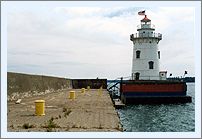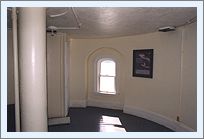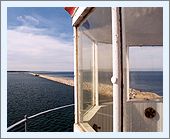|
Historical Information

While the stretch of coastline between the St. Clair River and Saginaw
Bay had been lighted at both ends by the Fort Gratiot Light since 1825
and at Pointe Aux Barques since 1848, there was no safe harbor to be
found along the 115 mile stretch between the two points. Thus, captains
encountering foul weather along this busy stretch of coastline were
forced to ride at the mercy of the open sea until safe shelter could be
made in either the Bay or River.
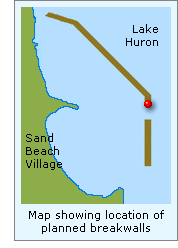 After
a number of wrecks occurred in the area at the turn of the 1870's, The
Federal Government realized that the construction of a harbor of refuge
close to the midpoint along this important stretch of coastline was
imperative. A Board of Engineers was assembled in Detroit on October 20,
1871 with instructions to identify the best location for the new harbor.
After an initial survey failed to identify a preferred location, Brevet Brigadier General
Orlando Metcalfe Poe
instructed of Captain Jarad A Smith to conduct a second survey, focusing
on Sand Beach and Port Hope. After completion of the survey, a
second Board of Engineers was convened on October 9, 1872, and after
identifying that 7,000 feet of breakwater would be required at Sand
Beach, while 10,000 would be required at Port Hope, Sand Beach was
selected as the site for the new harbor. As it turned out, Sand beach
was likely the preferable of the two points as a result of its location
at the approximate mid point between Port Huron and
Tawas Bay. After
a number of wrecks occurred in the area at the turn of the 1870's, The
Federal Government realized that the construction of a harbor of refuge
close to the midpoint along this important stretch of coastline was
imperative. A Board of Engineers was assembled in Detroit on October 20,
1871 with instructions to identify the best location for the new harbor.
After an initial survey failed to identify a preferred location, Brevet Brigadier General
Orlando Metcalfe Poe
instructed of Captain Jarad A Smith to conduct a second survey, focusing
on Sand Beach and Port Hope. After completion of the survey, a
second Board of Engineers was convened on October 9, 1872, and after
identifying that 7,000 feet of breakwater would be required at Sand
Beach, while 10,000 would be required at Port Hope, Sand Beach was
selected as the site for the new harbor. As it turned out, Sand beach
was likely the preferable of the two points as a result of its location
at the approximate mid point between Port Huron and
Tawas Bay.
A contract for the construction of the
piers was awarded to a private contractor, and work begin in 1873 with
the construction of ten timber cribs as a foundation for the center
pier. The rectangular hemlock cribs were erected on shore, towed out to
the line specified by Poe, and sunk in place with loads of stone. Many
local residents and farmers subcontracted to provide this stone, which
was gathered along the shore in private boats, or hauled to the
lakeshore from the fields inland, and loaded onto barges for transport
out to the pier line. By 1875, two contractors were working at the site.
The first continuing work on the 1,580-foot long main pier and the
second on the north pier.
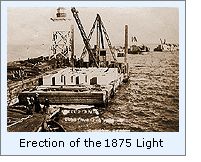 With work on the piers progressing
well, the first Light was erected at the elbow of the main pier in 1875.
Of typical pierhead beacon style, it consisted of an open timber frame,
pyramid tower, with its upper level immediately beneath the gallery
enclosed to create a combination watch and service room. An octagonal
cast iron lantern housed a fixed white Fourth Order Fresnel
lens, which
sat at a focal plane 44 feet above lake level. The Light was exhibited
for the first time on the evening of October 25, and was visible for a
distance of 13 miles. It is likely that this Light was tended by the
contractor through the remainder of the 1875 navigation season, as Acing
Keeper Thomas M Wallace and Acting First Assistant Willis P Graves do
not appear on official payroll records for the station until January 8,
1876. Evidently Wallace and Graves were less than suited for lighthouse
service, as they were both removed from service on September 18, 1878,
and replaced by Keeper Loren J Trescott and First Assistant Peter Dues.
By the end of 1878 season of navigation work on the piers had progressed
to a point that three quarters of the piers were complete, and enough of
the protected harbor had been dredged that the first vessels were
allowed to seek refuge in the harbor. With work on the piers progressing
well, the first Light was erected at the elbow of the main pier in 1875.
Of typical pierhead beacon style, it consisted of an open timber frame,
pyramid tower, with its upper level immediately beneath the gallery
enclosed to create a combination watch and service room. An octagonal
cast iron lantern housed a fixed white Fourth Order Fresnel
lens, which
sat at a focal plane 44 feet above lake level. The Light was exhibited
for the first time on the evening of October 25, and was visible for a
distance of 13 miles. It is likely that this Light was tended by the
contractor through the remainder of the 1875 navigation season, as Acing
Keeper Thomas M Wallace and Acting First Assistant Willis P Graves do
not appear on official payroll records for the station until January 8,
1876. Evidently Wallace and Graves were less than suited for lighthouse
service, as they were both removed from service on September 18, 1878,
and replaced by Keeper Loren J Trescott and First Assistant Peter Dues.
By the end of 1878 season of navigation work on the piers had progressed
to a point that three quarters of the piers were complete, and enough of
the protected harbor had been dredged that the first vessels were
allowed to seek refuge in the harbor.
In 1880, the Lighthouse Board requested
an appropriation of $5,000 for the construction of a dwelling for the
Sand Beach Keepers, having neglected to construct such a building when
the Light was established, causing Trescott and Dues to find housing in
town at their own expense. Eight more cribs were placed in 1881, and the
breakwall had reached a total length of 5,205 feet, and enclosed over
150 acres of harbor over 12 feet in depth. By the following year, the
piers had been lengthened to 8.200 feet, and with continued dredging and
blasting, over 300 acres of water over 12 feet in depth had been
protected. By this time, this immense construction project had consumed
over one million tons of iron, fifteen million board feet of lumber an
48,000 cords of stone, with costs totaling in excess of $900,000.
With an ever increasing number of
vessels tying-up to the breakwall and laying anchor within the harbor's
protection during storms, there were frequent accidents and arguments as
a result of the haphazard mooring of so many vessels. With over 1,000
vessels using the harbor in 1882, and the numbers expected to grow, it
became clear that some type of order would need to be brought to the
harbor. To this end, Captain Robert M Wagstaff was appointed as Harbor
Master in 1882. Armed with a set of harbor use rules, Wagstaff found
vessel masters willing to pay little attention to his directions. After
Wagstaff made arrangements with the local judge to levy fines against
transgressors, word of Wagstaff's strict enforcement practices spread
quickly throughout the maritime community and order was brought to the
harbor. Peter Dues accepted a promotion to the position of Acting Keeper
of the Ludington Pierhead Light on October 12, 1882. With no fog signal
at the station, Eleventh District Inspector Commander J. Crittenden
Watson made the decision to leave replace the Assistant Keeper position
unfilled, and thus Trescott was left to maintain the Light alone.
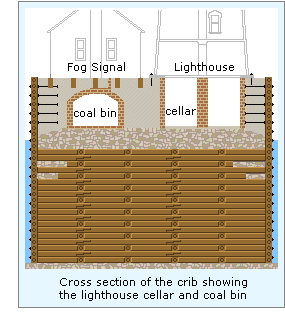 In May 1883, a vicious storm whipped
across Lake Huron, ripping large portions of the three inch plank facing
from the breakwall, twisting iron brackets and snapping the 12-inch
square breakwall timbers. Keeper Trescott, who was held captive within
the beacon reported that the noise of the storm was deafening, and with
the pier foundation moving with the force of the smashing waves, feared
that both he and the beacon would be swept away. Fortunately, Trescott
made it through the ordeal unscathed. However, it was clear that the
existing tower was not up to the task. With the completion of pier
construction expected within the next two years, District Engineer Major
Godfrey Weitzel draw up plans for the erection of a more substantial
cast iron tower and duplicate stem fog signals on a stand alone
foundation crib at the north side of the main harbor entry. Contracts
were awarded for the construction materials and mechanical components
that summer, and delivered to the Detroit depot in October. With the
close of the navigation season close at hand, the decision was made to
delay construction of the new light until the following spring. In May 1883, a vicious storm whipped
across Lake Huron, ripping large portions of the three inch plank facing
from the breakwall, twisting iron brackets and snapping the 12-inch
square breakwall timbers. Keeper Trescott, who was held captive within
the beacon reported that the noise of the storm was deafening, and with
the pier foundation moving with the force of the smashing waves, feared
that both he and the beacon would be swept away. Fortunately, Trescott
made it through the ordeal unscathed. However, it was clear that the
existing tower was not up to the task. With the completion of pier
construction expected within the next two years, District Engineer Major
Godfrey Weitzel draw up plans for the erection of a more substantial
cast iron tower and duplicate stem fog signals on a stand alone
foundation crib at the north side of the main harbor entry. Contracts
were awarded for the construction materials and mechanical components
that summer, and delivered to the Detroit depot in October. With the
close of the navigation season close at hand, the decision was made to
delay construction of the new light until the following spring.
Construction of the timber part of the foundation crib began on May 19,
1884 and was completed on June 25. The crib was then filled with stone
and decked over with planking to prevent the stone from being
washed-out. The upper level of the crib was laid in concrete, with a
circular brick-lined opening cast within to serve as a cellar for the
tower. Around the upper level of this cellar, a circular cast iron ring
secured to the concrete with 17 inch bolts was installed to serve as a
mounting flange for the tower walls. Ten feet to the north of this
cellar, a rectangular opening was formed in the concrete to serve as a
coal storage bin for the fog signal building which was to be erected
above. Construction of the fog signal building was underway with the
arrival of winter, and construction was ended until the beginning of the
1885 navigation season.
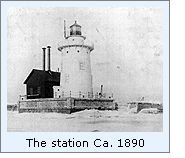 The work crew returned in May 1885, and
resumed work on the fog signal building and the erection of the cast
iron tower. The tower was constructed of prefabricated cast iron
segments, each 5/8 of an inch in thickness, with each segment bolted to
the adjacent segments. The tower contained four decks, with stairways
installed around the outer wall of each room to allow privacy to the
room within. The first deck served as a kitchen and common area, the
second deck as living quarters for the Assistants, the third deck as
living quarters for the Keeper, and the fourth deck as a work area and
watch room. The work crew returned in May 1885, and
resumed work on the fog signal building and the erection of the cast
iron tower. The tower was constructed of prefabricated cast iron
segments, each 5/8 of an inch in thickness, with each segment bolted to
the adjacent segments. The tower contained four decks, with stairways
installed around the outer wall of each room to allow privacy to the
room within. The first deck served as a kitchen and common area, the
second deck as living quarters for the Assistants, the third deck as
living quarters for the Keeper, and the fourth deck as a work area and
watch room.
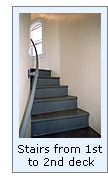 The watch room was surmounted by a small cylindrical machinery room
surrounded by a spacious gallery deck with an iron handrail. Atop this
gallery, an octagonal cast iron lantern was installed, and encircled by
a narrow gallery to provide the keepers with access to the exterior of
the lantern. The new lens, which was manufactured by Barbier &
Fenestre in Paris, featured 8 bull's eyes around its circumference,
four of which were fitted with red panels to impart alternating red and
white flashes. A clockwork motor rotated the lens around the lamp at a
precisely controlled speed that would alternately place the red and
clear bull's eyes between the light and the viewpoint of a
mariner every 10 seconds as follows: white flash 2.5 sec., eclipse
4 sec., red flash 2.5 sec, eclipse 8 sec. On completion, the
entire tower was given a coat of dark chocolate brown paint.
The watch room was surmounted by a small cylindrical machinery room
surrounded by a spacious gallery deck with an iron handrail. Atop this
gallery, an octagonal cast iron lantern was installed, and encircled by
a narrow gallery to provide the keepers with access to the exterior of
the lantern. The new lens, which was manufactured by Barbier &
Fenestre in Paris, featured 8 bull's eyes around its circumference,
four of which were fitted with red panels to impart alternating red and
white flashes. A clockwork motor rotated the lens around the lamp at a
precisely controlled speed that would alternately place the red and
clear bull's eyes between the light and the viewpoint of a
mariner every 10 seconds as follows: white flash 2.5 sec., eclipse
4 sec., red flash 2.5 sec, eclipse 8 sec. On completion, the
entire tower was given a coat of dark chocolate brown paint.
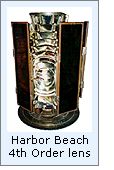 The fog signal building was of timber
frame construction, and sheathed with corrugated iron on its exterior
which was painted with the same brown paint used in the tower. Smooth
iron sheeting on the interior walls was painted white in order to
reflect the light entering through the five small windows. Twin boilers
and fire boxes were installed on elevated pads on the concrete floor,
and plumbed into a pair of 10-inch steam whistles, which were mounted at
the gable of the building. A pair of iron stacks which exited on each
side of the roof ridge served to exhaust the smoke and excess steam from
both boilers. Since the new station would include responsibility for the
main Light, the steam fog signal and three ancillary lights located on
the breakwaters, it was clear to Eleventh District Inspector Commander
Francis A. Cook that two Assistants would be needed at the station.
Keeper Trescott managed to pull some strings to have his younger brother
Alva appointed as the station's First Assistant, and local resident Ira
W Goodrick appointed as Second Assistant, with both of them appearing on
station payroll records on August 20. As the work drew close to
completion at the end of September, The Trescott's and Second Assistant
Goodrick moved into the new tower. As the work crew continued to put the
finishing touches to the station around them, Keeper Trescott exhibited
the new Light for the first time on the night of October 1, 1885. Their
work complete, the construction crew departed for the Detroit depot
seven days later. Now complete, the breakwaters protecting the harbor
stood over 8,000 feet in length, and sheltered deep water area
encompassing 650 acres. Completed at a cost of $1,205,781, the harbor of
refuge quickly became known by the nickname "million dollar
harbor." The fog signal building was of timber
frame construction, and sheathed with corrugated iron on its exterior
which was painted with the same brown paint used in the tower. Smooth
iron sheeting on the interior walls was painted white in order to
reflect the light entering through the five small windows. Twin boilers
and fire boxes were installed on elevated pads on the concrete floor,
and plumbed into a pair of 10-inch steam whistles, which were mounted at
the gable of the building. A pair of iron stacks which exited on each
side of the roof ridge served to exhaust the smoke and excess steam from
both boilers. Since the new station would include responsibility for the
main Light, the steam fog signal and three ancillary lights located on
the breakwaters, it was clear to Eleventh District Inspector Commander
Francis A. Cook that two Assistants would be needed at the station.
Keeper Trescott managed to pull some strings to have his younger brother
Alva appointed as the station's First Assistant, and local resident Ira
W Goodrick appointed as Second Assistant, with both of them appearing on
station payroll records on August 20. As the work drew close to
completion at the end of September, The Trescott's and Second Assistant
Goodrick moved into the new tower. As the work crew continued to put the
finishing touches to the station around them, Keeper Trescott exhibited
the new Light for the first time on the night of October 1, 1885. Their
work complete, the construction crew departed for the Detroit depot
seven days later. Now complete, the breakwaters protecting the harbor
stood over 8,000 feet in length, and sheltered deep water area
encompassing 650 acres. Completed at a cost of $1,205,781, the harbor of
refuge quickly became known by the nickname "million dollar
harbor."
To render the Light more visible, the
speed of lens rotation was increased on the opening of the 1886
navigation season to create alternating read and white flashes every
five seconds. The following year was almost certainly a memorable one
for the Sand Beach Keepers, as the fog signal was kept in operation for
a total of 465 hours, which turned out to be an all time high for the
station.
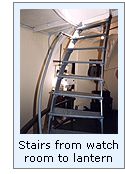 An example of the import role played by
the Sand Beach Harbor of Refuge can be found in the logs of the
lighthouse tender DAHLIA for 1891. On October 20 of that year, the
tender was headed north out of Port Huron with three new lightships
destined for Simmons Reef, White Shoal and Grays Reef in tow. Running
into foul weather, she set course for the safety of Sand Beach.
Releasing the three lightships just outside the harbor, she stood off
and watched as the three lightships made their way between the
breakwaters under their own power, before following them through the gap
herself. On arriving in the harbor, they found over 90 vessels already
tied-up alongside the breakwaters or at anchor to ride-out the storm.
The entire sheltered fleet spent the following two days in the harbor's
protection until the storm finally let up on the 23rd, and the fleet was
able to finally make way in safety. An example of the import role played by
the Sand Beach Harbor of Refuge can be found in the logs of the
lighthouse tender DAHLIA for 1891. On October 20 of that year, the
tender was headed north out of Port Huron with three new lightships
destined for Simmons Reef, White Shoal and Grays Reef in tow. Running
into foul weather, she set course for the safety of Sand Beach.
Releasing the three lightships just outside the harbor, she stood off
and watched as the three lightships made their way between the
breakwaters under their own power, before following them through the gap
herself. On arriving in the harbor, they found over 90 vessels already
tied-up alongside the breakwaters or at anchor to ride-out the storm.
The entire sheltered fleet spent the following two days in the harbor's
protection until the storm finally let up on the 23rd, and the fleet was
able to finally make way in safety.
As the nineteenth century drew to a
close, it was evident that the harbor of refuge was a successful
endeavor, as a total of 1,216 vessels sought the harbor's shelter during
the year, and in the twenty-five years since the harbor was first opened
in 1874, 47,460 mariners had tied up along the breakwaters to ride out
rough weather on the lake. In order to allow the tower to serve as a
more efficient day mark, the tower was repainted white in 1900, and the
wrought iron hand railing encircling the gallery was renewed.
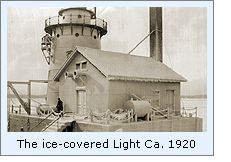 In 1903, it was discovered that the
wooden breakwaters were deteriorating, and the Army Corps of Engineers
set about replacing the above water timber structures with a concrete
superstructure. Work began in June 1904, with a full-time crew of
sixteen men. A shore station was established, where timber forms were
erected for casting concrete breakwater sections. Each concrete section
consumed 200 barrels of cement and sand, and weighed 380 tons on
completion. The wooden breakwaters were removed to a depth of three feet
below the water's surface, leveled and refilled with stone, and capped
with the pre-poured concrete sections, which were taken out to the
breakwall by barge, and hoisted into place by a steel derrick mounted to
the barge deck. As part of this renovation, the wooden face of the
lighthouse and fog signal crib was stripped to six inches below the
water line, and the face was rebuilt with vitrified brick and protected
with steel plates and oak fenders. In 1903, it was discovered that the
wooden breakwaters were deteriorating, and the Army Corps of Engineers
set about replacing the above water timber structures with a concrete
superstructure. Work began in June 1904, with a full-time crew of
sixteen men. A shore station was established, where timber forms were
erected for casting concrete breakwater sections. Each concrete section
consumed 200 barrels of cement and sand, and weighed 380 tons on
completion. The wooden breakwaters were removed to a depth of three feet
below the water's surface, leveled and refilled with stone, and capped
with the pre-poured concrete sections, which were taken out to the
breakwall by barge, and hoisted into place by a steel derrick mounted to
the barge deck. As part of this renovation, the wooden face of the
lighthouse and fog signal crib was stripped to six inches below the
water line, and the face was rebuilt with vitrified brick and protected
with steel plates and oak fenders.
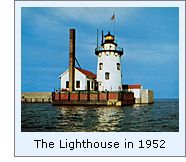 The next few years saw some major
turnover at the station after Alva Trescott, the station's First
Assistant, resigned from lighthouse service in 1910, to be replaced by
George Mahan. Mahan had been serving as Second Assistant since 1888, and
was in turn replaced by Andrew Henderson who transferred-in from Thunder
Bay Island. Loren Trescott himself resigned in 1912, after 34 years of
faithful service as Keeper of the Sand Beach Harbor of Refuge Lights.
Trescott was relieved by Archibald Davidson who was appointed directly
to the position without any previous lighthouse service. The next few years saw some major
turnover at the station after Alva Trescott, the station's First
Assistant, resigned from lighthouse service in 1910, to be replaced by
George Mahan. Mahan had been serving as Second Assistant since 1888, and
was in turn replaced by Andrew Henderson who transferred-in from Thunder
Bay Island. Loren Trescott himself resigned in 1912, after 34 years of
faithful service as Keeper of the Sand Beach Harbor of Refuge Lights.
Trescott was relieved by Archibald Davidson who was appointed directly
to the position without any previous lighthouse service.
On June 30, 1914, the illuminating
apparatus within the lens was upgraded from oil wick to incandescent oil
vapor, with a significant increase in the effectiveness of the light.
With the upgrade, the intensity of the white flash was increased from
5,600 to 33,000 candlepower, and the red flash from 1,400 to 10,000
candlepower. On July 15, 1919, the 10" steam boilers and 10-inch
whistles were removed from the fog signal building and replaced by a
pair of Type "F" diaphones.
1935 saw the installation of a radio
beacon at the station, which would allow mariners on the lake to obtain
their bearings through triangulation with the Corsica Shoal Lightship.
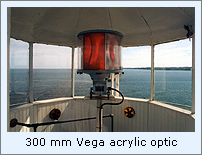 With the Coast Guard's assumption of
responsibility for the nation's aids to navigation in 1939, the old
civilian "Wickies" were given the option of either maintaining
their civilian status, or transferring into the Coast Guard. Keeper Otto
Both, who had served as Keeper at the station since 1935, when he
transferred-in from the Cheboygan Range Lights, where he had been
serving as First Assistant, appears to have elected neither course as he
resigned from lighthouse service one year later in 1940. At some time
during the 1960's the Fourth Order Fresnel lens was removed from the
lantern, and replaced with a 300
mm Vega acrylic optic, which still shines its light across the
harbor to this day. The Fourth Order lens is displayed in the Grice
Museum, at the entrance to the Harbor Beach marina, where it holds a
prime corner of their local history display. With the Coast Guard's assumption of
responsibility for the nation's aids to navigation in 1939, the old
civilian "Wickies" were given the option of either maintaining
their civilian status, or transferring into the Coast Guard. Keeper Otto
Both, who had served as Keeper at the station since 1935, when he
transferred-in from the Cheboygan Range Lights, where he had been
serving as First Assistant, appears to have elected neither course as he
resigned from lighthouse service one year later in 1940. At some time
during the 1960's the Fourth Order Fresnel lens was removed from the
lantern, and replaced with a 300
mm Vega acrylic optic, which still shines its light across the
harbor to this day. The Fourth Order lens is displayed in the Grice
Museum, at the entrance to the Harbor Beach marina, where it holds a
prime corner of their local history display.

Keepers of
this Light

Click here
to see a complete listing of all Harbor Beach Light keepers compiled by
Phyllis L. Tag of Great Lakes Lighthouse Research.

Seeing this Light

During our first visit to Harbor Beach, we could immediately see that
we were going to be unable to get any close-up images of this
lighthouse since it sits on a free-standing crib off a breakwater which
is detached from land at either end. We made our way out to the end of
the fishing pier that stretches into the protected harbor, since the
offshore end of this pier would place us at the closest point to the
light we could find without the benefit of a boat. Using the 170 to
500mm zoom set all the way out at 500mm, we were able to capture a
couple of reasonable shots of the structure.
We then made our way to the Harbor Beach Library, where we nosed through
the books and files, gleaning information about the history of the
harbor and its light. The library is housed in an interesting appearing building. At some time, a
local artist has painted a two-story mural illustrating scenes from the
town's past on the old front facade. While the library contains very
little information about the lighthouse and the harbor, both the
building and the mural are well worth a visit.
In September 2002, we were fortunate to
be invited to tour the lighthouse with Skip Kadar of the HBL&BPS,
and spent an extremely enjoyable day with Skip exploring the station
from top to bottom.

Finding this
Light

From m-25, turn East onto Trescott Street, follow the road to the the
beach, and park in one of the beach parking areas. The fishing pier is
located at the end of the street, and the lighthouse is directly beyond
the end of the fishing pier.

Reference
Sources

Annual reports of the Lighthouse
Board, various,1876 - 1909
Annual reports of the Lake Carrier's Association, 1906 -
1940
Inventory of Historic
Light Stations, National Parks Service 1994
Harbor Beach Centennial, Harbor Beach Historical Society.
Harbor Beach Breakwall Lighthouse Preservation Society, photographic
archives
Great Lakes Light Lists, various, 1876 - 1901
ESSAYONS, A history of the Detroit District, USACE, John W
Larson, 1981
Email correspondence with Skip Kadar, HBBLPS, various, 5/14/00 - 9/15/02
Personal visits to Harbor Beach, 05/05/00 & 09/14/02
Photographs from the author's personal collection.
Keeper listings for this light appear courtesy of Tom & Phyllis Tag
|
